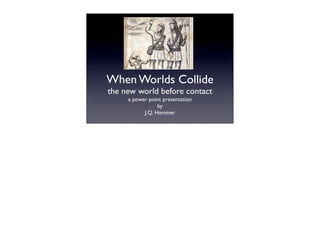NING Project 5 #1
- 1. When Worlds Collide the new world before contact a power point presentation by J.Q. Hammer
- 2. The 2 Great Civilizations • In 1491, two great civilizations ruled large parts of the New World: the Incas in the Andes Mountains of Peru and the Mexica, or the Triple Alliance, in Mesoamerica, a region running from Central Mexico south to Honduras. • These cultures both had strong leaders driven to expand their empires, had swiftly conquered neighboring lands, and had built large, beautiful capitals to reflect their power and grandeur.
- 3. Dominance • As the Incas and the Mexica were in 1491, they had only become pre-eminent in the century before Columbus. • They were the latest in a 4000- year long line of cultures that arose, reached their peaks, and declined or disappeared as a result of conquest, changes in climate and weather conditions, destruction of their environments, or internal divisions.
- 4. The Ways of the Ancients • From Norte Chico, the first urban complex in the Americas, begun around 3000 BC, to the Olmecs (1200 - 200 BC) who created the first cities in North America and the Zapotec (600 BC - 800 AD) who developed writing around 600 BC , a number of civilizations were long gone by the time the Spanish landed. • In their wake, these societies left tantalizing clues to their lifestyles and belief systems: great pyramids, enormous earthen mounds, and ruins of sophisticated aqueducts and ritual centers that would not be discovered or begin to be scientifically analyzed until the 20th century.
- 5. The Heart of Invention • Since 1800 BC, Mesoamerica was the homeland of a series of developing cultures responsible for significant advances in agriculture, architecture, and communications. • The Olmecs, Zapotecs, Toltecs, and Teotihuacan were just a few of the civilizations that flourished there as people abandoned pure hunter/gatherer lifestyles and began to live communally in villages and cities. • They created pottery, artwork, and spiritual belief sets; developed intricate political and religious structures; established markets and trade; and domesticated plants and cultivated crops. • They also invented writing, one of only two indisputable times in human history that writing was invented independently. T • The people of Mesoamerica created many systems of pictorial writing and at least two full writing systems.




